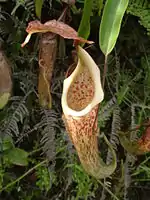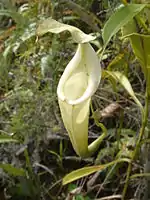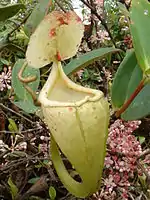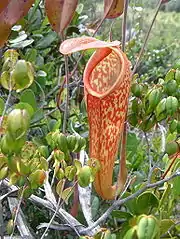大猪笼草
大猪笼草[3](学名:)是一种广布于苏拉威西[3]、新几内亚[3]和摩鹿加群岛[4]的热带食虫植物。其也可能存在于沃沃尼島。[5]
| 大猪笼草 | |
|---|---|
 | |
| 产自苏拉威西的大猪笼草上位笼,海拔约400米 | |
| 保护状况 | |
| 科学分类 | |
| 界: | 植物界 Plantae |
| 演化支: | 被子植物 Angiosperms |
| 演化支: | 真双子叶植物 Eudicots |
| 目: | 石竹目 Caryophyllales |
| 科: | 猪笼草科 Nepenthaceae |
| 属: | 猪笼草属 Nepenthes |
| 种: | 大猪笼草 N. maxima |
| 二名法 | |
| Nepenthes maxima Reinw. ex Nees (1824) | |
| 異名 | |
| |
大猪笼草被归入“大猪笼草系”中,其中还包括博世猪笼草(N. boschiana)、陈氏猪笼草(N. chaniana)、附生猪笼草(N. epiphytica)、艾玛猪笼草、法萨猪笼草(N. faizaliana)、暗色猪笼草(N. fusca)、克洛斯猪笼草(N. klossii)、宽唇猪笼草(N. platychila)、窄叶猪笼草(N. stenophylla)和佛氏猪笼草(N. vogelii)。[6]
常见于苏拉威西的某些变型常具有明显波浪状的叶片。[4][7]个别极端个体的叶片翼即使下延至下部整个节间,但其仍可能呈高度波浪状。[8]这种波浪状的叶片是由于叶缘细胞生长造成的,由于其叶片质薄,从而导致其叶片呈波浪状以降低其应力势能。[9]
虽然柯蒂斯猪笼草(N. curtisii)为该物种的异名,但其也被用于指代其他许多栽培种。
形态特征
大猪笼草捕虫笼的形态特征多变。捕虫笼可为纯绿色或带斑点,少数斑点众多,几乎为黑色。不同变型的唇也存在差异,产自新几内亚的变型其唇较宽。[3]





产于苏拉威西的大猪笼草上位笼,其生长的海拔高度从左至右一至三为400米、四至五为700米





产于新几内亚的大猪笼草上位笼,其生长的海拔高度从左至右分别为1500米、1600米、1700米、2300米和2600米
种下类群
- Nepenthes maxima f. undulata Sh.Kurata (1985)
- Nepenthes maxima var. glabrata Becc. in sched. nom.nud.
- Nepenthes maxima var. lowii (Hook.f.) Becc. (1886) [=N. stenophylla]
- Nepenthes maxima var. minor Macf. (1917)
- Nepenthes maxima var. sumatrana (Miq.) Becc. (1886) [=N. sumatrana]
- Nepenthes maxima var. superba (Hort.Veitch ex Marshall) Veitch (1897)
2009年,一种产自婆娑湖的栽培品种被命名为婆娑湖大猪笼草(Nepenthes maxima‘Lake Poso’)[10]
自然杂交种
- ? N. eymae × N. maxima[4]
- N. glabrata × N. maxima[4]
- N. klossii × N. maxima[10]
- N. maxima × N. neoguineensis[4]
- N. maxima × N. tentaculata[11]
 无毛猪笼草与大猪笼草的疑似自然杂交种
无毛猪笼草与大猪笼草的疑似自然杂交种 克洛斯猪笼草与大猪笼草的自然杂交种
克洛斯猪笼草与大猪笼草的自然杂交种 大猪笼草与新几内亚猪笼草的自然杂交种
大猪笼草与新几内亚猪笼草的自然杂交种
参考文献
- (拉丁文) Hooker, J.D. 1873. Ordo CLXXV bis. Nepenthaceæ. In: A. de Candolle Prodromus Systematis Naturalis Regni Vegetabilis 17: 90–105.
- Masters, M.T. 1887. New or noteworthy plants. Nepenthes Curtisii, Mast., sp. nov.. The Gardeners' Chronicle, series 3, 2(49): 681, 689.
- 夏洛特. . 台北: 商周出版. 2007: 60. ISBN 978-986-124-850-9.
- McPherson, S.R. 2009. Pitcher Plants of the Old World. 2 volumes. Redfern Natural History Productions, Poole.
- (印尼文) Sunarti, S., A. Hidayat & Rugayah 2008. Keanekaragaman tumbuhan di hutan Pegunungan Waworete, Kecamatan Wawonii Timur, Pulau Wawonii, Sulawesi Tenggara. 页面存档备份,存于 [Plants diversity at the mountain forest of Waworete, East Wawonii District, Wawonii Island, Southeast Sulawesi.] Biodiversitas 9(3): 194–198.
- Robinson, A.S., J. Nerz & A. Wistuba 2011. Nepenthes epiphytica, a new pitcher plant from East Kalimantan. In: McPherson, S.R. New Nepenthes: Volume One. Redfern Natural History Productions, Poole. pp. 36–51.
- [Anonymous] 2013. BE-3543 Nepenthes maxima - wavy leaf.PDF Nepenthes Growers Newsletter 2(2): 7–8.
- Bourke, G. 2010. Plant profile: Nepenthes maxima.PDF Captive Exotics Newsletter 1(1): 9–10.
- Sharon, E., M. Marder & H.L. Swinney 2004. Leaves, flowers and garbage bags: making waves. 页面存档备份,存于 American Scientist 92(3): 254–261.
- Evans, D.P. 2009. New Cultivars: Nepenthes maxima ‘Lake Poso’ 页面存档备份,存于. Carnivorous Plant Newsletter 38(1): 18–22.
- McPherson, S.R. & A. Robinson 2012. Field Guide to the Pitcher Plants of Sulawesi. Redfern Natural History Productions, Poole.
- [Anonymous] 1889. Nepenthes at Messrs. Veitch's. 页面存档备份,存于 The Gardeners' Chronicle, series 3, 6(145): 388.
- [Anonymous] 2010. Eramet-PT Weda Bay Nickel Exploration and Development ESIA. 页面存档备份,存于 ERM Indonesia, Jakarta.
- Adam, J.H., C.C. Wilcock & M.D. Swaine 1992. The ecology and distribution of Bornean Nepenthes.PDF Journal of Tropical Forest Science 5(1): 13–25.
- Adam, J.H. 1997. Prey spectra of Bornean Nepenthes species (Nepenthaceae) in relation to their habitat.PDF Pertanika Journal of Tropical Agricultural Science 20(2–3): 121–134.
- Adam, J.H. & C.C. Wilcock 1999. Palynological study of Bornean Nepenthes (Nepenthaceae).PDF Pertanika Journal of Tropical Agricultural Science 22(1): 1–7.
- Amoroso, V.B., L.D. Obsioma, J.B. Arlalejo, R.A. Aspiras, D.P. Capili, J.J.A. Polizon & E.B. Sumile 2009. Inventory and conservation of endangered, endemic and economically important flora of Hamiguitan Range, southern Philippines. Blumea 54(1–3): 71–76. doi:10.3767/000651909X474113
- Amoroso, V.B. & R.A. Aspiras 2011. Hamiguitan Range: a sanctuary for native flora. Saudi Journal of Biological Sciences 18(1): 7–15. doi:10.1016/j.sjbs.2010.07.003
- Bauer, U., C.J. Clemente, T. Renner & W. Federle 2012. Form follows function: morphological diversification and alternative trapping strategies in carnivorous Nepenthes pitcher plants. Journal of Evolutionary Biology 25(1): 90–102. doi:10.1111/j.1420-9101.2011.02406.x
- Beveridge, N.G.P., C. Rauch, P.J.A. Keßler, R.R. van Vugt & P.C. van Welzen 2013. A new way to identify living species of Nepenthes (Nepenthaceae): more data needed! Carnivorous Plant Newsletter 42(4): 122–128.
- (拉丁文) Blume, C.L. 1852. Ord. Nepenthaceae. 页面存档备份,存于 In: Museum Botanicum Lugduno-Batavum, sive stirpium exoticarum novarum vel minus cognitarum ex vivis aut siccis brevis expositio. Tom. II. Nr. 1. E.J. Brill, Lugduni-Batavorum. pp. 5–10.
- Bonhomme, V., H. Pelloux-Prayer, E. Jousselin, Y. Forterre, J.-J. Labat & L. Gaume 2011. Slippery or sticky? Functional diversity in the trapping strategy of Nepenthes carnivorous plants. New Phytologist 191(2): 545–554. doi:10.1111/j.1469-8137.2011.03696.x
- Clarke 等. . IUCN Red List of Threatened Species. 2000. [12 May 2006].
- Clarke, C.M. 2006. Introduction. In: Danser, B.H. The Nepenthaceae of the Netherlands Indies. Natural History Publications (Borneo), Kota Kinabalu. pp. 1–15.
- (印尼文) Darma, I.D.P., I.P. Suendra & H.-M. Siregar 2004. BP-17: Keanekaragaman Nepenthes di Taman Wisata Alam Nanggala III, Luwu, Sulawesi Selatan. [Nepenthes diversity in Taman Wisata Alam Nanggala III, Luwu, Sulawesi Selatan.] [pp. xiv–xv] In: Abstrak: Konggres dan Seminar Nasional Penggalang Taksonomi Tumbuhan Indonesia (PTTI) Universitas Sebelas Maret Surakarta, 19-20 Desember 2003. 页面存档备份,存于 Sisipan Biodiversitas 5(1): i–xxxii.
- (印尼文) Darma, I.D.P., I.P. Suendra & H.-M. Siregar 2004. Keanekaragaman Nepenthes di Taman Wisata Alam Nanggala III, Luwu, Sulawesi Selatan 页面存档备份,存于. [Diversity of Nepenthes at ecotour forest Nanggala III, Luwu, South Sulawesi.] BioSMART 6(2): 126–129.
- Dixon, W.E. 1889. Nepenthes. 页面存档备份,存于 The Gardeners' Chronicle, series 3, 6(144): 354.
- James, G. 1993. Some observations of carnivorous plants in habitat, Sulawesi: Indonesia.PDF Carnivorous Plant Newsletter 22(1–2): 29–30.
- Kitching, R.L. 2000. Food Webs and Container Habitats: The natural history and ecology of phytotelmata 页面存档备份,存于. Cambridge University Press, Cambridge.
- Lecoufle, M. 1990. Nepenthes maxima. In: Carnivorous Plants: Care and Cultivation. Blandford, London. pp. 124–125.
- (印尼文) Mansur, M. 2001. Koleksi Nepenthes di Herbarium Bogoriense: prospeknya sebagai tanaman hias.PDF In: Prosiding Seminar Hari Cinta Puspa dan Satwa Nasional. Lembaga Ilmu Pengetahuan Indonesia, Bogor. pp. 244–253.
- Masters, M.T. 1889. Nepenthes Curtisi. The Gardeners' Chronicle, series 3, 6(154): 660–661.
- Masters, M.T. 1890. New or noteworthy plants. Nepenthes stenophylla, Mast., sp. n. 页面存档备份,存于. The Gardeners' Chronicle, series 3, 8(192): 240.
- McPherson, S.R. & A. Robinson 2012. Field Guide to the Pitcher Plants of Australia and New Guinea. Redfern Natural History Productions, Poole.
- Meimberg, H., A. Wistuba, P. Dittrich & G. Heubl 2001. Molecular phylogeny of Nepenthaceae based on cladistic analysis of plastid trnK intron sequence data. Plant Biology 3(2): 164–175. doi:10.1055/s-2001-12897
- (德文) Meimberg, H. 2002. Molekular-systematische Untersuchungen an den Familien Nepenthaceae und Ancistrocladaceae sowie verwandter Taxa aus der Unterklasse Caryophyllidae s. l..PDF Ph.D. thesis, Ludwig Maximilian University of Munich, Munich.
- Meimberg, H. & G. Heubl 2006. Introduction of a nuclear marker for phylogenetic analysis of Nepenthaceae. Plant Biology 8(6): 831–840. doi:10.1055/s-2006-924676
- Meimberg, H., S. Thalhammer, A. Brachmann & G. Heubl 2006. Comparative analysis of a translocated copy of the trnK intron in carnivorous family Nepenthaceae. Molecular Phylogenetics and Evolution 39(2): 478–490. doi:10.1016/j.ympev.2005.11.023
- (日語) Oikawa, T. 1992. Nepenthes maxima Reinw.. In: Muyū kusa – Nepenthes(). [The Grief Vanishing.] Parco Co., Japan. p. 62.
- Porter, J.N. 1940. Note on the germination of Nepenthes seed sown on agar 页面存档备份,存于. Botanical Museum Leaflets Harvard University 8(3): 65–68.
- Renner, T. & C.D. Specht 2011. A sticky situation: assessing adaptations for plant carnivory in the Caryophyllales by means of stochastic character mapping. International Journal of Plant Sciences 172(7): 889–901. doi:10.1086/660882
- Renner, T. & C.D. Specht 2012. Molecular and functional evolution of class I chitinases for plant carnivory in the Caryophyllales. Molecular Biology and Evolution 29(10): 2971–2985. doi:10.1093/molbev/mss106
- Rischer, R., M. Wenzel, J. Schlauer, G. Bringmann & L.A. Assi 1998. In vitro cultivation and experiments with carnivorous plants.PDF In: J. Schlauer & B. Meyers-Rice (eds.) Proceedings: Second Conference of the International Carnivorous Plant Society. International Carnivorous Plant Society, Fullerton. pp. 6–7.
- Rischer, R., M. Wenzel, J. Schlauer, G. Bringmann & L.A. Assi 1998. In vitro cultivation and experiments with carnivorous plants.PDF In: J. Schlauer & B. Meyers-Rice (eds.) Proceedings: Second Conference of the International Carnivorous Plant Society. International Carnivorous Plant Society, Fullerton. pp. 6–7.
- Shin, K.-S., S. Lee & B.J. Cha 2007. Suppression of phytopathogenic fungi by hexane extract of Nepenthes ventricosa x maxima leaf. Fitoterapia 78(7–8): 585–586. doi:10.1016/j.fitote.2007.03.020
- Slack, A. 1979. Nepenthes maxima. In: Carnivorous Plants. Ebury Press, London. p. 86.
- Thorogood, C. 2010. The Malaysian Nepenthes: Evolutionary and Taxonomic Perspectives. Nova Science Publishers, New York.
- Toma, I., C. Toma & I. Stănescu 2002. Histo-anatomical aspects of the Nepenthes maxima Reinw. ex Ness metamorphosed leaf.PDF Revue Roumaine de Biologie, Série de Biologie Végétale 47(1–2): 3–7.
This article is issued from Wikipedia. The text is licensed under Creative Commons - Attribution - Sharealike. Additional terms may apply for the media files.